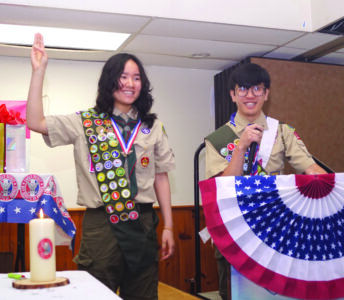Camouflaged within the industrial streets of East Flatbush stands a workshop where Lou Nasti, an engineer of the holidays, creates Christmas fairy tales. A troupe of gray synthetic mythical creatures, an elephant and two old skeletons guard the main entrance.
The inside of the 15,000-square-foot factory looks like any other workshop. Carpentry and machinery areas are displayed along with painting, costume and set-up rooms. However, after crossing a blue-lit entranceway vitalized by harp-melodies, there stands a door that reads “Welcome to my world.”
Enchanting scenery unveils behind the door. Christmassy little creatures come to life around the room. Dozens of pointy-eared elves dance and bounce while a family of teddy bears woodwork at a carpenter shop and dressed-up figurines dance at a music saloon.
Nasti, a small-framed man, runs the show here. Brooklyn-born, gray-haired and exhibiting a seizable mustache, he is known as “Geppetto” for his many similarities to the fictional woodcarver. He has been creating eye-popping Christmas displays for over 50 years.
“I can be called worse with a name like Nasti,” he joked, presuming his natural talent for laughing at himself. “I guess I’m the real Geppetto of Brooklyn.”
Lou Nasti Mechanical Display started as a small shop on Flatbush Avenue not long after the 17-year-old Nasti was featured in the New York Times in 1965 for building a six-foot-tall robot.
“I love mechanical mechanisms. I could not leave the house without coming back with a piece of junk, a television, wheels, gear, something, so I had to understand how things work,” he said. “I wanted to build a robot as a hobby and it turned out to be the stepping stone in my life.”
About 16 years after he started his small enterprise, it became a promising company with a 90,000-square-foot factory and 63 employees that created Christmas windows for New York flagship stores like Gimbels, Lord & Taylor, Macy’s, Saks, Best & Co. and B. Altman, many of which went bankrupt long ago.
However, Nasti was very unhappy.
“I realized that what I was selling wasn’t the quality that I wanted,” he said.
Trusting the reputation he had built during almost a decade of work, Nasti decided to take the company down.
With almost a quarter of the space and 12 employees, he devoted his renovated business to creating custom displays, not only for department stores but for casinos, theatres, amusement parks and houses around the globe.
At Nasti’s workshop, Christmas runs year-round.
The day after Thanksgiving, he and his five men unpacked a truck with the decorations for the famous three-story Polizzotto house at 1145 84th St. in Dyker Heights that Nasti has been gearing up for the holiday season for more than three decades.
“A friend of mine called Frank Leone said to me ‘I want you to decorate my lawyer’s house,’” Nasti recalled, explaining that it was Leone’s gift to Alfred Polizzotto, who was at the time in Florida.
“I decorated the house [and] it looked like Rockefeller Center,” Nasti said cheerily.
Hanging from the second floor of the white-stucco house, Nasti led the team to hoist the 15-foot-tall wooden mechanical soldiers that every year rise gracefully on either side of the front door. In the early morning, the group mounted two carousels and a troop of small soldiers.
By the end of the day, a 350-pound Santa, two epic white mechanical horses, six large pedestals and a cast of elves completed the display, a tradition that Florence Polizzotto continues in honor of her husband, who died 17 years ago.
“Santa gets a new coat every year and he gets a new beard. Sometimes the pigeons sit on top of his head and mess him up a little, so we have to make sure he doesn’t go out looking like an old dirty Santa,” Nasti said, chuckling.
After decades in the Christmas business, Nasti considers the holiday’s original meaning to have changed.
“There is less religion in it,” he said. “It’s very difficult to celebrate the tradition of Christmas, the birth of Christ, because a lot of people who celebrate Christmas don’t believe in Christ.”
For Nasti, details like replacing the word “Christmas” with “holidays” on written contracts or having to take away the rising star from Christmas trees, reflect how companies want to avoid the religious tone of the season.
“The feeling of Christmas has changed,” he said. “But if you really look at it you can’t see the difference; it’s still Christmas.”








 U.S. Army vet inducted into the NY State Senate Veterans Hall of Fame
U.S. Army vet inducted into the NY State Senate Veterans Hall of Fame  On the Avenue: Troop 18G honors 2nd Eagle Scout
On the Avenue: Troop 18G honors 2nd Eagle Scout